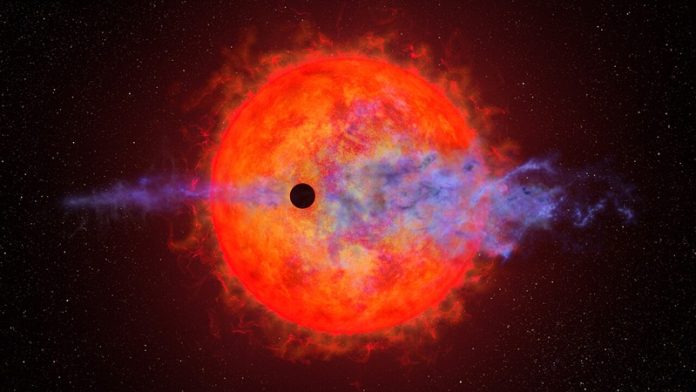
Astronomers have witnessed an extraordinary sight in space, 32 light-years away from Earth, in a star system named AU Microscopii.
Here, a fiery star is seen bullying its closest planet, AU Microscopii b, or AU Mic b for short. This star, which is a red dwarf, is pretty young, only 1% as old as our sun.
Imagine it like this: AU Mic, the star, is a toddler with a big temper.
It’s prone to throwing super-powerful tantrums, which we call “super-flares”. These tantrums are 100 to 1,000 times stronger than similar ones from our own sun.
And they create a dangerous sunburn-like effect, meaning anyone living there would need a super-strong “sunscreen 5,000”!
Now, AU Mic b, the planet, is like a little toy close to this fiery toddler. It’s about four times the size of Earth and orbits really close to the star, only 6 million miles away.
Because of this closeness, the planet is at the mercy of the star’s tantrums. Its atmosphere, made mostly of hydrogen, is slowly being blown away like dust in a strong wind.
Interestingly, this doesn’t happen all at once or consistently, but in stops and starts, like hiccups! The Hubble Space Telescope noticed that during one period, it looked like the planet wasn’t losing any atmosphere.
But a year and a half later, it was clearly losing some again.
This was a surprise for the scientists, who expected the process to be much more predictable.
Keighley Rockcliffe, a scientist from Dartmouth College, compared the sight to a headlight on a fast-moving train.
She explained that this unpredictable behaviour makes AU Mic b a perfect case to study and learn more about how planets evolve.
The AU Mic system is interesting because it’s one of the youngest ever observed. The star is less than 100 million years old and the system only has one known planet, AU Mic b.
This planet was discovered by NASA’s Spitzer and TESS telescopes in 2020.
As you might know, red dwarf stars like AU Mic are the most common type in our Milky Way galaxy. They likely host most of the galaxy’s planets.
But can these planets support life? That’s a big question. Red dwarfs have intense tantrums for much longer than stars like our sun. This, along with powerful winds and harmful radiation, can make life there quite challenging.
So, Rockcliffe and other scientists are trying to figure out what kind of planets can survive this tough environment.
Can they ever be home to life, or will they just end up being burnt and lifeless? We don’t know yet, but observing systems like AU Mic will help answer these questions.
To do this, scientists use the Hubble Space Telescope to monitor changes in the star’s brightness. This can tell us how much hydrogen the planet is losing. One theory is that the star’s tantrums can affect how visible this loss is.
For example, a strong tantrum could make the escaping hydrogen invisible to our telescopes. But more observations are needed to confirm this and other theories.
The findings from AU Mic b’s strange behaviour were published in The Astronomical Journal, with Rockcliffe as the lead author. Future observations promise to reveal more about this fascinating star-planet pair.
Follow us on Twitter for more articles about this topic.



